Intel(R) PROSet/Wireless is used to setup, edit and manage network profiles to connect to a network. It also includes advanced settings such as power management and channel selection for setting up ad-hoc networks.
If you use Microsoft(R) Windows(R) XP Wireless Zero Configuration as your wireless manager, you can disable it from the Microsoft Windows Wireless Network tab.
To disable Microsoft Windows XP Wireless Zero Configuration as your wireless manager:
NOTE: Check that the Application Settings option Notify when another application uses the wireless adapter is selected. This option prompts you when Microsoft Windows XP Wireless Zero Configuration starts to manage your network profiles.
To start Intel PROSet/Wireless use one of the following methods:
Exit Intel PROSet/Wireless:
To close Intel PROSet/Wireless from the main window use one of the following:
To start Intel(R) PROSet/Wireless, double-click the Taskbar icon ![]() located in the lower right corner of your Windows desktop or right-click the Taskbar icon and click Open Intel PROSet/Wireless.
located in the lower right corner of your Windows desktop or right-click the Taskbar icon and click Open Intel PROSet/Wireless.

The Intel PROSet/Wireless icon displays on the Taskbar located in the lower right corner of your Windows desktop. Right-click the status icon to display the menu options.
Menu Item |
Comments |
Open Intel PROSet/Wireless |
Click to start Intel PROSet/Wireless when Intel PROSet/Wireless is your wireless manager. If you select Use Windows to manage Wi-Fi from the Taskbar menu, the menu option changes to Open Wireless Zero Configuration and Microsoft Windows XP Wireless Zero Configuration Service is used as your wireless manager. When you use Microsoft Windows, you cannot use your Intel profiles. |
Open Wireless Zero Configuration |
|
If you have Intel PROSet/Wireless installed, the current state of the radio displays in the Intel PROSet/Wireless main window and on the Taskbar. Select Wireless On to turn the radio on. Select Wireless Off to turn the radio off. If your computer has an external switch installed, use it to switch the radio on or off. Refer to your computer manufacturer's documentation for more information about this switch. |
|
Wireless Off |
|
802.11a Radio Off |
This option is available only for wireless adapters that support 802.11a, 802.11b, and 802.11g. Select to turn off the 802.11a radio. NOTE: This setting is unavailable unless it is set in the Administrator Tool or if your adapter is an Intel(R) PRO/Wireless 2200BG Network Connection. |
Open Intel Wireless Troubleshooter |
Opens an application that can assist you to resolve wireless network connection issues. When a connection issue is detected, a desktop alert appears at the bottom right corner of your desktop. See Intel Wireless Troubleshooter for more information. |
Connect to Profile |
Displays the current profiles in the Profile list. Used also to connect to a profile. |
Use Windows to manage Wi-Fi |
Toggles between the Intel PROSet/Wireless and Microsoft Windows XP Wireless Zero Configuration Service. When you use Microsoft Windows, you cannot use your Intel profiles. |
Use Intel PROSet/Wireless to manage Wi-Fi |
The Taskbar icon provides visual indication of the current wireless connection state. The connection status icon is located on the lower right corner of your Windows desktop. The Taskbar icon can be set to display or be hidden in the Tools Menu Application Settings.
Icon |
Description |
|
Wireless Off: The wireless adapter is off. The wireless device does not transmit or receive while it is off. Click Wireless On to enable the adapter. The icon is white and static. |
Searching for wireless networks: The wireless adapter searches for any available wireless networks. The icon is white with animation. |
|
|
No wireless networks found: There are no available wireless networks found. Intel PROSet/Wireless periodically scans for available networks. If you want to force a scan, double-click the icon to launch Intel PROSet/Wireless and click Refresh. The icon is red. |
|
Wireless network found: An available wireless network is found. Double-click the icon to display the Wireless Networks list. Select the network. Click Connect. The icon is yellow. |
|
Authentication failed: Unable to authenticate with wireless network. The icon is green with a yellow warning triangle. |
Connecting to a wireless network: Flashes while an IP address is being obtained or an error occurs. |
|
|
Connected to a wireless network: Connected to a wireless network. A Tool Tip displays network name, speed, signal quality and IP address. The icon is green with waves that reflect signal quality. The more waves, the better the signal quality. |
The Tool Tips and Desktop Alerts provide feedback and interaction. To display Tool Tips, move your mouse pointer over the icon. Desktop alerts are displayed when your wireless network changes state. For example, if you are out of range of any wireless networks, a desktop alert is displayed when you come into range.
Select Show Information Notifications in the Application Settings to enable desktop alerts.
Tool tips display when the mouse pointer rolls over the icon. The tool tips display text for each of the connection states.

When user action is required, a desktop alert displays. If you click the alert, then an appropriate action is taken. For example when wireless networks are found, the following alert displays:

Action: Click the desktop alert to connect to network in the Wireless Networks list.
Once connected, the alert displays the wireless network that you are connected to, the speed of the connection, signal quality and IP address.

Desktop alerts are also used to indicate if there is a connection problem. Click the alert to open the Intel Wireless Troubleshooter.
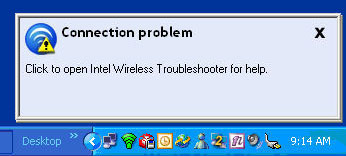
The Intel PROSet/Wireless Main Window allows you to:
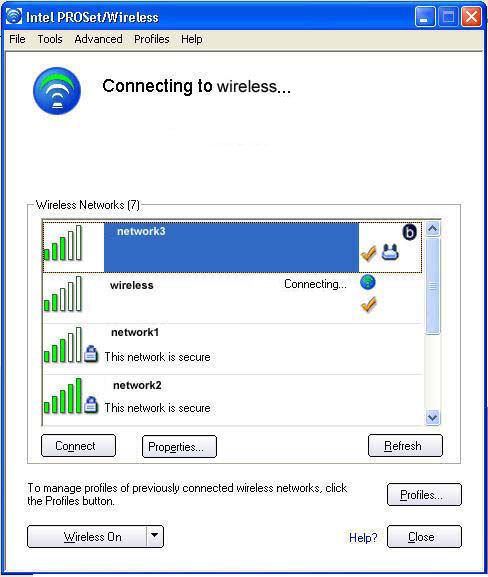
Use the Intel PROSet/Wireless to:
The Intel PROSet/Wireless main window displays connection status icons which indicate the current connection status of your wireless adapter. The Taskbar icon also indicates the current connection status. Refer to Taskbar Icons for more information.
The icons are used to designate connection status.
Icon |
Description |
|---|---|
Wireless Off: The radio is not associated to a network. Click the Wireless On button to enable the radio. |
|
Indicates connection problems including authentication failures. |
|
Searching for wireless networks: The wireless adapter is scanning for any available wireless networks. Animated Icons:
|
|
No wireless networks found: The adapter does not find any wireless networks. |
|
Wireless network found: An available wireless network is found. You can choose to connect to available networks displayed in the Wireless Networks list. |
|
Connecting to a wireless network. You are connecting to a wireless network. The crescent shaped curves switch between green and white until an IP Address is obtained or a connection error occurs. |
|
Connected to a wireless network: You are connected to a wireless network. The network name, speed, signal quality, and IP address display the current connection status. Click the Details button to display details of the current network connection. |
|
Network Name |
Network Name (SSID): This is the name of the network that the adapter is connected to. The Network Name SSID must be the same as the SSID of the access point. |
Signal Quality |
The signal quality icon bars indicate the quality of the transmit and receive signals between your wireless adapter and the nearest access point or computer in Device to Device (ad hoc) mode. The number of vertical green bars indicates the strength of the transmit and receive signals. The signal quality ranges from excellent to out of range. The following factors affect signal quality:
|
Properties |
Provides adapter connection status information. See Properties Button for information. |
Wireless On (Off) |
Switch the radio off and on. Refer to Turn Wireless On or Off for more information. |
Help? |
Provides help information for this page. |
Close |
Closes the Intel PROSet/Wireless main window. |
The Wireless Networks list displays a list of wireless networks within range of the adapter.
Name |
Description |
|
The signal strength of the wireless network access point or computer (Device to Device [ad hoc] mode). The signal strength icon bars indicate that the wireless network or computer is available for connection but is still not is associated with an access point or computer (Device to Device [ad hoc] mode). |
Network Name |
Network Name (SSID): The name of the network that the adapter is connected to. The Network Name SSID must be the same as the SSID of the access point. |
Status |
Notification that the adapter is connecting to the wireless network. Once connected, the status is changed to Connected. |
Profiles: Identifies a network in the Wireless Networks list that is connected and has a profile in the profiles list. |
|
|
The wireless network uses Network (infrastructure) mode. |
|
The wireless network uses Device to Device (ad hoc) mode. |
|
The wireless network uses Security encryption. |
The band frequency being used by the wireless network (802.11a, 802.11b, 802.11g). |
|
The wireless network is on the exclusion list or the profile is configured for manual connection. |
|
Connect (Disconnect) |
Click to connect to a wireless network. Once connected, the button changes to Disconnect. |
Properties |
Provides detailed information about the connected network and its access points. See Network Properties for information. |
Refresh |
Refreshes the list of available networks. If any new networks are available within the adapter range, the list is updated to show the new network name. |
Wireless On (Wireless Off) |
Switch the radio off and on. Refer to Wireless Off (On) for more information. |
Close |
Closes the Intel PROSet/Wireless main window. |
Help? |
Provides help information for this page. |
Click the Properties button on the Intel PROSet/Wireless main window to display the security settings for the wireless adapter. You can also add profiles to be excluded from automatic connection. If network exclusion is enabled (see Application Settings) then the Network Properties also indicates if the network is excluded from automatic connection.
Name |
Description |
Network Name |
Displays the wireless network name. |
Band |
Current band and frequency being used. Displays Out of Range if no band and frequency is displayed. The following bands are listed:
|
Operation Mode |
Displays the current operating mode:
|
Authentication Level |
Displays the current authentication security mode for the profile being used. The following network authentication levels are listed:
Displays the 802.11 authentication used by the currently used profile. Refer to Security Settings for more information. |
Data Encryption |
The following Data Encryption settings are listed:
Refer to Security Settings for more information. |
|
|
Manage Exclusions |
Refer to Manage Exclusions for more information. |
Close |
Closes the Network Properties. |
Help? |
Provides help information for this page. |
When you are connected to a network, you can click the Details button on the Intel PROSet/Wireless main window to display the Connection Details.
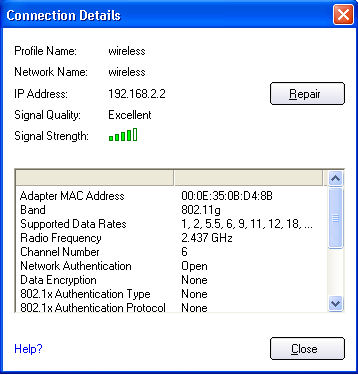
Name |
Description |
Profile Name |
Name of the profile. |
Network Name |
Network Name (SSID) of the current connection. |
IP Address |
Internet Protocol (IP) address for the current connection. |
Signal Quality |
A radio frequency (RF) signal can be assessed by two components:
The quality of the signal is determined by a combination of factors. Primarily it is composed of signal strength and the ratio of the RF noise present. RF noise occurs both naturally and artificially by electrical equipment. If the amount of the RF noise is high, or the signal strength is low, it results in a lower signal to noise ratio which causes poorer signal quality. With a low signal to noise ratio, it is difficult for the radio receiver to discern the data information contained in the signal from the noise itself. |
Signal Strength |
The signal strength for all received packets. The more green bars displayed, the stronger the signal. |
Adapter MAC Address |
Media Access Control (MAC) address for the wireless adapter. |
Band |
Indicates the wireless band of the current connection.
|
Supported Data Rates |
Rates at which the wireless adapter can send and receive data. Displays the speed in Mbps for the frequency being used.
|
Radio Frequency |
Displays the frequency of the current wireless connection.
|
Channel Number |
Displays the transmit and receive channel. |
Network Authentication |
Displays Open, Shared, WPA-Personal and WPA2-Personal modes, WPA-Enterprise, and WPA2-Enterprise. Displays the 802.11 authentication used by the currently used profile. Refer to Security Overview for more information. |
Data Encryption |
Displays None, WEP, TKIP or AES-CCMP. Refer to Security Overview for more information. |
802.1x Authentication Type |
Displays None, MD5, EAP-SIM, TLS, TTLS, PEAP, LEAP, or EAP-FAST. Refer to Security Ovewrview for more information. |
802.1x Authentication Protocol |
Displays None, PAP, MD5, GTC, CHAP, MS-CHAP, MS-CHAP-V2 or TLS. Refer to Security Overview for more information. |
CCX Version |
Version of the Cisco Compatible Extensions on this wireless connection. |
Current TX Power |
Cisco Compatible Extensions Power Levels. |
Supported Power Levels |
1.0, 5.0, 20.0, 31.6, 50.1 mW |
Access Point MAC Address |
The Media Access Control (MAC) address for the associated access point. |
Displays None, if not enabled. If enabled, from the Mandatory Access Point setting, the access point MAC address is displayed. This option directs the wireless adapter to connect to an access point that uses a specific MAC address (48-bit 12 hexadecimal digits, for example, 00:06:25:0E:9D:84). |
|
Repair |
Renews the IP Address. If you have trouble accessing the network, verify if the IP address is valid. If it is 0.0.0.0 or 169.x.x.x, then it is probably not valid. If your network is setup for automatic network address assignment, then click Repair and request a new IP address. |
Close |
Closes the page. |
Help? |
Provides help information for this page. |
The Profiles List displays the current user profiles in the order that they are to be applied. Use the up and down arrows to arrange profiles in a specific order to automatically connect to a wireless network.
Use the Connect button to connect to a wireless network. Once connected, a profile is created in the Profiles list. You can also add, edit, and remove profiles from the Profiles 'list.
Different profiles can be configured for each wireless network. Profile settings can include, the network name (SSID), operating mode, and security settings. See Profile Management for more information.
Name |
Description |
|
Network settings that allow your wireless adapter to connect to a network access point (infrastructure mode) or computer (Device to Device [ad hoc]) mode which does not use an access point. Refer to Set up Profiles for more information. |
||
Network Name |
Name of the wireless network (SSID) or computer. |
|
Connection Icons: The network profile status icons indicate the different connection states of the adapter with a wireless network, the type of operating mode being used, and whether network security is being used. |
||
Blue circle: The wireless adapter is associated with an access point or computer (Device to Device [ad hoc] mode). If a profile has 802.1x security enabled, this indicates that the wireless adapter is associated and authenticated. |
||
|
Indicates infrastructure mode. |
|
|
Indicates Device to Device (ad hoc) mode. |
|
Indicates an Administrator profile. |
||
|
The wireless network uses Security encryption. |
|
Arrows
|
Position profiles in a preferred order for auto-connection.
|
|
Connect |
Connect the selected profile for the wireless network. |
|
Use the Profile Wizard to create a new profile. Refer to Create a New Profile for more information. |
||
Removes a selected profile from the Profile list. Refer to Delete a Profile for more information. |
||
Used to edit the contents of an existing profile. You can also double-click a profile in the Profile list to edit the profile. Refer to Edit an Existing Profile for more information. |
||
|
Export/Import: Imports and exports user-based profiles to and from the Profile list. Wireless profiles can be automatically imported into the Profile list. See Import and Export Profiles for more information. |
|
Close |
Closes the profile management window. |
|
Use the File, Tools, Advanced, Profiles and Help menus to configure your network settings.
Name |
Description |
File |
Exit: Close the Intel PROSet/Wireless main window. Use one of these options to start the Intel PROSet/Wireless Software:
|
Tools |
Application Settings: Use to set system wide connection preferences. Refer to Application Settings for information. Use Ctrl+P from your keyboard as an alternative to access this feature. Intel Wireless Troubleshooter: Use to resolve wireless network connection problems. Use Ctrl+W from your keyboard as an alternative to access this feature. Refer to Intel Wireless Troubleshooter for more information. Administrator Tool: Used by administrators or the person who has administrator privileges on this computer to configure shared profiles (Pre-logon, Persistent and Voice over IP (VoIP)). Refer to Administrator Tool for more information. Use Ctrl+T from your keyboard as an alternative to access this feature. NOTE: The Administrator Tool is available only if it installed during a custom installation of the Intel PROSet/Wireless software. Refer to Install or Uninstall the Software for more information on custom installation. |
Advanced |
Adapter Settings: Displays Adapter Settings which correlates to the settings in the Microsoft Windows Advanced settings. Refer to Adapter Settings for information. Use Ctrl+A from your keyboard as an alternative to access this feature. To access Adapter Settings from Microsoft Windows:
Advanced Statistics: Select to determine how the adapter communicates with an access point. Use Ctrl+S from your keyboard as an alternative to access this feature. Refer to Advanced Statistics for more information. Use Windows to manage Wi-Fi: Select to enable Microsoft Windows XP Wireless Zero Configuration as the wireless manager. Use F10 from your keyboard as an alternative to access this feature. Refer to Switch to Microsoft Windows XP Wireless Zero Configuration for more information. |
Profiles |
Manage Profiles: Select to create or edit profiles. Use Ctrl+R from your keyboard as an alternative to access this feature. Manage Exclusions: Select to exclude networks from automatic connection. Refer to Manage Exclusions for more information. Use Ctrl+M from your keyboard as an alternative to access this feature. |
Help |
Intel PROSet/Wireless Help: Starts the online help. Use F1 from your keyboard as an alternative to access this feature. To navigate the help window:
About: Displays version information for the currently installed application components. |

The settings on this page control the behavior of the Intel PROSet/Wireless software.
Name |
Description |
Adapter |
Lists the network adapter that are currently available. It may be either an Intel(R) PRO/Wireless 3945ABG Network Connection, an Intel(R) PRO/Wireless 3945BG Network Connection, an Intel(R) PRO/Wireless 2915ABG Network Connection or, an Intel(R) PRO/Wireless 2200BG Network Connection. |
Advanced Settings: The following settings control how Intel PROSet/Wireless behaves and displays information. |
|
Taskbar |
Show application icon on the taskbar: Select to display the Taskbar status icon. This icon resides on the Windows Taskbar (Notification Area). This icon provides the status of your wireless connection. Clear to not display the Taskbar status icon. The Taskbar Status Icon provides several functions:
|
Show Alert Notifications: Select to display desktop alerts next to the taskbar icon. When your action is required, a message displays. Only events of high importance trigger a desktop alert. If the desktop alert is selected, then the appropriate action is taken. Clear to not display desktop alerts. Refer to Tool Tips and Desktop Alerts for more information. Select one of the following options: Information Notifications: These desktop alerts are of lower importance. They do not require your interaction but can greatly improve the wireless experience.
Notify when another application uses the wireless adapter: When selected, a message is displayed when other applications are trying to manage your wireless adapter. This is helpful if you use software provided by a hotspot location (coffee shop, airport terminal). To take advantage of the Intel PROSet/Wireless features, disable this software when you leave the hotspot. Enable TLS rejected certificates notification: Select if you want a warning issued when a PEAP-TLS certificate is rejected by the authentication server. See Enterprise Security and Set up the Client for TLS authentication for more information. |
|
Connect to available network using profiles only: (Default) Connect the wireless adapter to an available network with a matching profile from the Profiles List. If no matching profile is found, you are notified (see Notifications). The wireless device remains disconnected until a matching profile is found or you configure a new matching profile. Connect to any available network if no matching profile found: Select to connect to a network automatically if you have not configured a profile and are at a location that has an open, unsecured wireless network. NOTE: Open networks have no security. You would need to provide your own security for this wireless connection. One way to secure an open wireless connection is with Virtual Private Networking (VPN) software. Connect to any network based on profiles only (Cisco mode): Select to try every profile in preferred order. This signifies that you are in the vicinity of an access point which has more than one SSID but only advertises one. |
|
Manage Exclusions |
Enable automatic exclude list feature: Select to enable the automatic exclude list feature. This feature provides a way to exclude access points from automatic connection. Refer to Manage Exclusions for more information. Enable manual exclude list feature: Select to enable the manual exclude list feature. This feature provides a way to exclude networks from automatic connection. Refer to Manage Exclusions for more information. |
Show column sort headers: Select to display the column names in the Wireless Networks list. Click on a column header to sort the column in either ascending or descending order. |
|
OK |
Save settings and return to the previous page. |
Cancel |
Closes and cancels changes. |
Help? |
Provides help information for this page. |
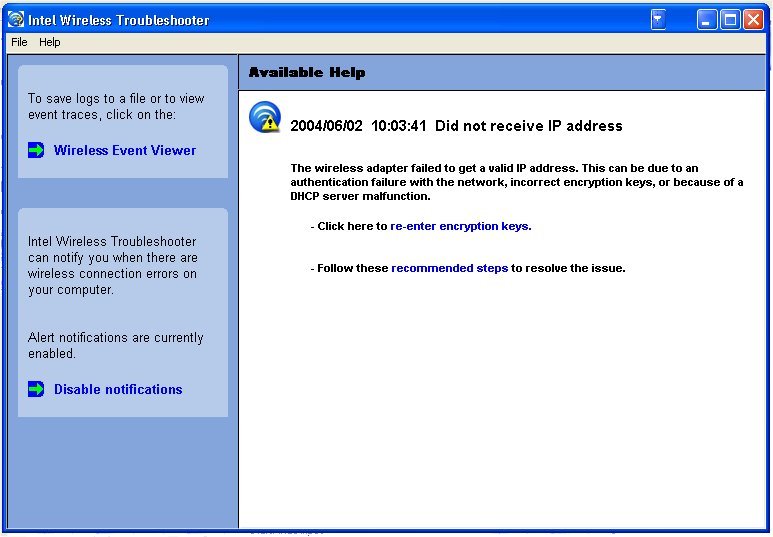
Intel Wireless Troubleshooter is an application that can help you resolve wireless network connection issues. When a connection issue is detected, a desktop alert appears at the bottom right corner of your desktop. Once you click the desktop alert, a diagnostic message displays the recommended steps to resolve the connection problem. For example, if a connection problem occurred because of an invalid password, the Profile Wizard application is launched when you click a displayed hyperlink. You can also launch Wireless Event Viewer and enable or disable alert notifications. The Intel Wireless Troubleshooter is supported under Microsoft Windows XP and Microsoft Windows 2000
The Intel Wireless Troubleshooter page contains two panes. Use your left mouse button on the left pane to display a list of available tools. The right pane displays the current connection issue in a section. Each section has two parts: the error message and the recommended action. The recommended action contains descriptions about available utilities and helps to resolve the associated connection issue. If you click a help link, the help text is displayed in a window. If you click the associated issue resolution link, a program is launched to resolve the connection issue.
Refer to the Troubleshooting section for information on resolving errors.
Name |
Description |
File |
Exit: Exits Intel Wireless Troubleshooter application. |
Help |
Intel(R) Wireless Troubleshooter Help: Displays online help on the Intel Wireless Troubleshooter. About: Displays version information for the Intel Wireless Troubleshooter. |
Wireless Event Viewer |
Launches Wireless Event Viewer. |
Disable Notification |
Select to disable the alert notifications. |
Enable Notification |
Select to enable the alert notifications. |
Available Help |
Date Time error message:
|
The Administrator tool is for administrators or the person who has administrator privileges on this computer. This tool allows the administrator to restrict what level of control the users of this computer have over their wireless connections. This tool is used also to configure common (shared) profiles.
Users cannot modify Administrator settings or profiles unless they have the password for this tool. A password should be chosen that is secure and not easily guessed.
You can export these settings and profiles as one package to other computers on your network. For more information, refer to the Administrator Tool section.
|
Name |
Description |
|
Application Settings |
An administrator can select which level of control that users have over their wireless network connections. Refer to Administrator Tool Application Settings. |
|
Administrator Profiles |
Enable or disable Persistent, Pre-Logon and Voice over IP (VoIP) profiles on the computer. Refer to Administrator Tool Profiles. |
Adapter Settings |
An administrator can select which level of control that users have over their wireless network connections. Refer to Administrator Tool Adapter Settings. |
Software |
Select which of the Intel PROSet/Wireless applications are installed on a user's computers. Refer to Administrator Tool Software. |
Administrator Packages |
The Administrator Packages are used to save administrative profiles and other settings. You can copy or send this self-extracting executable to clients on your network. When it is run, the contents are installed and configured on the destination computer. Refer to Administrator Tool Packages. |
|
Change Password |
Change the password for the Administrator Tool. See Change Password for more information. |
|
Close |
Closes the page. |
|
Help? |
Provides help information for this page. |
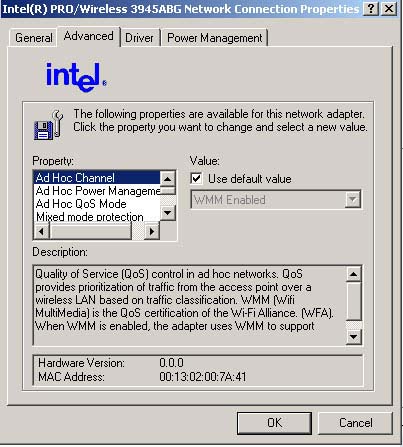
The Adapter Settings displays the device properties for the wireless adapter installed on your computer. It may be either an Intel(R) PRO/Wireless 3945ABG Network Connection, an Intel(R) PRO/Wireless 2915ABG Network Connection or, an Intel(R) PRO/Wireless 2200BG Network Connection.
Adapter Settings Description
Name |
Description |
|---|---|
Ad Hoc Channel |
Unless the other computers in the ad hoc network use a different channel from the default channel, there is no need to change the channel. Value: Select the allowed operating channel from the list.
NOTE: When an 802.11a channel is not displayed, ad hoc networks are not supported for the channel. |
Ad Hoc Power Management |
Set power saving features for Device to Device (ad hoc) networks.
NOTE: This setting is unavailable if the adapter is an Intel PRO/Wireless 3945BG Network Connection, an Intel PRO/Wireless 2915ABG Network Connection, or an Intel PRO/Wireless 2200BG Network Connection. |
Ad Hoc QoS Mode |
Quality of Service (QoS) control in ad hoc networks. QoS provides prioritization of traffic from the access point over a wireless LAN based on traffic classification. WMM (Wifi MultiMedia) is the QoS certification of the Wi-Fi Alliance (WFA). When WMM is enabled, the adapter uses WMM to support priority tagging and queuing capabilities for Wi-Fi networks.
NOTE: This setting is unavailable if the adapter is an Intel PRO/Wireless 3945BG Network Connection, Intel PRO/Wireless 2915ABG Network Connection or an Intel PRO/Wireless 2200BG Network Connection. |
Mixed mode protection |
Use to avoid data collisions in a mixed 802.11b and 802.11g environment. Request to Send/Clear to Send (RTS/CTS) should be used in an environment where clients may not hear each other. CTS-to-self can be used to gain more throughput in an environment where clients are in close proximity and can hear each other. |
Preamble Mode |
Changes the preamble length setting received by the access point during an initial connection. Always use a long preamble length to connect to an access point. Auto Tx Preamble allows automatic preamble detection. If supported, short preamble should be used. If not, use long preamble (Long Tx Preamble). NOTE: This setting is unavailable if the adapter is an Intel PRO/Wireless 3945ABG Network Connection. |
Preferred Band |
Select the operating band. The selections are:
NOTE: This setting is unavailable if the adapter is an Intel PRO/Wireless 3945ABG Network Connection or Intel PRO/Wireless 2200BG Network Connection. |
Roaming Aggressiveness |
This setting allows you to define how aggressively your wireless client roams to improve connection to an access point.
|
Throughput Enhancement |
Changes the value of the Packet Burst Control.
|
Transmit Power |
Default Setting: Highest power setting Lowest Minimum Coverage: Set the adapter to a lowest transmit power. Enable you to expand the number of coverage areas or confine a coverage area. Reduce the coverage area in high traffic areas to improve overall transmission quality and avoid congestion and interference with other devices. Highest Maximum Coverage: Set the adapter to a maximum transmit power level. Select for maximum performance and range in environments with limited additional radio devices. NOTE: The optimal setting is for a user to always set the transmit power at the lowest possible level still compatible with the quality of their communication. This allows the maximum number of wireless devices to operate in dense areas and reduce interference with other devices that this radio shares radio spectrum with. NOTE: This setting takes effect when either Infrastructure or Ad hoc mode is used. |
Select which band to use for connection to a wireless network:
NOTE: These wireless modes (Modulation type) determine the discovered access points displayed in the Wireless Networks list. |
|
OK |
Saves settings and returns to the previous page. |
Cancel |
Closes and cancels any changes. |
Provides current adapter connection information. The following describes information for the Advanced Statistics page.
Name |
Description |
Statistics |
Advanced Statistics: This information pertains to how the adapter communicates with an access point. Association: If the adapter finds an access point to communicate with, the value is in range. Otherwise, the value is out of range.
Roaming: This information contains counters that are related to reasons for the adapter roaming. Roaming occurs when an adapter communicates with one access point and then communicates with another for better signal strength.
Miscellaneous: Use this information to determine if an association with a different access point increases performance and helps maintain the highest possible data rate.
|
Transmit/Receive (Tx/Rx) Statistics |
Displays percent values for non-directed and directed packets. Total host packets: The sum total number of directed and non-directed packets counts.
Non-directed packets: The number of received packets broadcast to the wireless network. Directed packets: The number of received packets sent specifically to the wireless adapter. Total Bytes: The total number of bytes for packets received and sent by the wireless adapter. |
Reset Statistics |
Resets the adapter statistical counters back to zero and begins taking new data measurements. |
Close |
Closes and returns to the main window. |
Help? |
Provides help information for this page. |
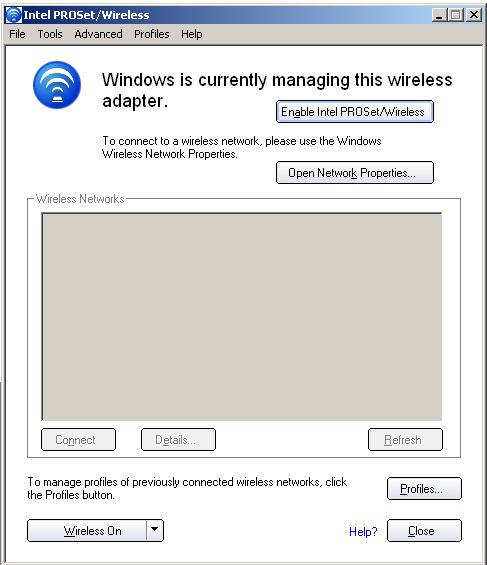
The Microsoft Windows XP Wireless Zero Configuration feature provides a built-in wireless configuration utility. This feature can be enabled and disabled within Intel PROSet/Wireless. Click Use Windows to manage Wi-Fi on the Advanced menu or the Taskbar menu. If Windows XP Wireless Zero Configuration is enabled, the features in Intel(R) PROSet/Wireless are disabled.
Exclude List Management is available when you either select Manage Exclusions from the Profiles menu or click the Properties button on the Wireless Networks list.
IMPORTANT: You are not automatically connected to a network or an access point that is in this list.
Use Exclude List Management to exclude entire wireless networks (SSID). For networks with more then one access point, you may exclude an individual wireless access point (BSSID).
Name |
Description |
|
Exclude List Management |
NOTE: Entries that are dimmed are excluded rouge access points. A rogue access point is any access point unsanctioned by network administrators. These entries cannot be removed from the list. |
|
Add |
Add a network name (SSID) to the list. |
|
Remove |
Remove an entry from the list.
|
|
Reset list |
Removes all of the networks and access points from the Exclude List. |
|
Close |
Closes page and saves settings. |
|
Help? |
Provides help information for this page. |
To switch the wireless radio on or off, use one of the following:
NOTE: When your computer is switched on, the radio is constantly transmitting signals. In certain situations, as in an airplane, signals from the radio may cause interference. Use the following methods if you need to disable the radio and use your notebook without emitting radio signals.
If your computer has an external switch installed, use it to switch the radio on or off. Refer to the computer manufacturer for more information about this switch. If you have Intel PROSet/Wireless installed, the current state of the radio displays in the Intel PROSet/Wireless main window and on the Taskbar.
From Intel PROSet/Wireless, the radio can be switched on or off. The status icon on Intel PROSet/Wireless displays the current state of the radio.
From the Intel PROSet/Wireless main Window, click Wireless On or Wireless Off to toggle the radio on or off.
To switch the radio off or on, click the Taskbar icon and select Wireless On or Wireless Off.
The radio can be disabled (made non-functional) from the Microsoft Windows Device Manager.
NOTE: If you disabled the radio from Microsoft Windows, then you must use Microsoft Windows to turn the radio on. You cannot use a hardware switch or Intel PROSet/Wireless to enable the radio again.
A Typical install includes the Wireless LAN adapter driver, the Intel PROSet/Wireless software, Intel(R) Smart Wireless Solutions, and the Intel Wireless Troubleshooter.
The follow features are installed during a Custom installation:
To install these features, select Custom during installation. Follow the instructions below to install these features. If Intel PROSet/Wireless is already installed, see the post-installation instructions.
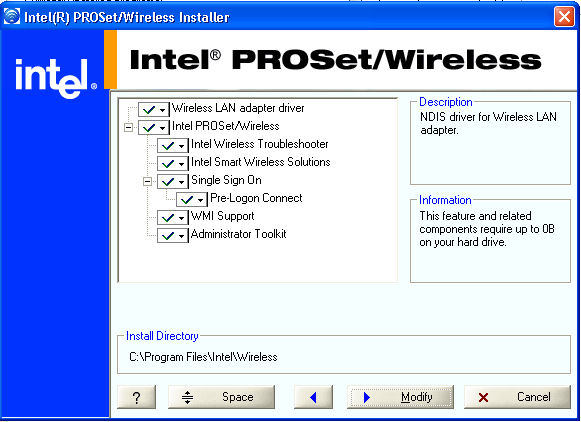
NOTE: If you plan to use Novell(R) Client(TM) for Windows, it should be installed prior to installation of the Intel PROSet/Wireless software. If Intel PROSet/Wireless is already installed, you should remove it prior to installation of Novell Client for Windows.
Intel PROSet/Wireless: The Intel PROSet Wireless application software.
- Install: Click Intel PROSet Wireless. Select Install this feature and all subfeatures. Proceed to step 8.
- Not install: Click This feature will not be available. A red x displays next to the option indicates that it is not to be installed.
Intel Smart Wireless Solutions: Provides an easy configuration wizard for connection to a wireless router.
- Install: Click Intel Smart Wireless Solutions. Select Install this feature and all subfeatures. Proceed to step 8.
- Not Install: Select This feature will not be available. A red x displays next to the option indicates that it is not to be installed.
Intel Wireless Troubleshooter: Helps you resolve wireless connection issues.
WMI Support: Wireless Management Instrumentation functionality allows administrators who do not have Intel PROSet/Wireless installed to manage remotely clients that do have Intel PROSet/Wireless installed.
- Install: Click WMI Support. Select Install this feature and all subfeatures. Proceed to step 8.
- Not install: Click This feature will not be available. A red x displays next to the option indicates that it is not be installed.
Administrator Toolkit: Installs the Administrator Tool to the Tools menu. This tool is used to configure common (shared) profiles. The Administrator Tool is also used by an Information Technology department to enable or disable features within the Intel PROSet/Wireless software.
- Install: Click Administrator Toolkit . Select Install this feature and all subfeatures. Click Next and proceed to step 8.
- Not Install: Select This feature will not be available. A red x displays next to the option indicates that it is not to be installed.
Single Sign On: Installs the Single Sign On features.This tool is used to configure common (shared) profiles with the Administrator Tool.
The Fast User Switching and the Microsoft Windows XP Welcome Screen are disabled when Single Sign On support is installed.
Single Sign On is targeted to the enterprise environment where users logon to their computer with a user name, password and typically a domain. Fast User Switching does not support domain log on.
NOTE: Windows Fast User Switching is enabled by default if you use Microsoft Windows XP Home Edition. It is targeted for the home user; Fast User Switching is also available on Microsoft Windows XP Professional if you install it on a stand alone or workgroup-connected computer. If a computer running Microsoft Windows XP Professional is added to a domain, then Fast User Switching option is not available.
Pre-Logon Connect: A Pre-Logon profile is active once a user logs onto the computer.
- Install: Click Single Sign On. Select Install this feature and all subfeatures. Click Next and proceed to step 8.
- Not Install: Select This feature will not be available. A red x displays next to the option indicates that it is not to be installed.
NOTE: When Pre-Logon Connect is installed, you are asked to reboot after installation of the software.
If Intel PROSet/Wireless is already installed, follow the instructions below to add the Administrator Tool, Intel Smart Wireless Solutions, Wireless Management Instrumentation functionality and Pre-Logon Connect:
To uninstall Intel PROSet/Wireless:
You have chosen to completely remove the Intel PROSet/Wireless software.
Select what to do with your current profiles and settings.
- Do not save my profiles and settings. Select to completely remove all of your current profiles and settings. If you reinstall the software, the profiles and settings are no longer available.
- Save my profiles and settings in the current format (Intel PROSet/Wireless 10.x). Select to save your current profiles and settings. If you reinstall the software, your current profiles and settings are available.
- Convert and save my profiles and settings in Intel PROSet/Wireless 9.x format. If you need to revert to a previous version of Intel PROSet/Wireless software, select to save your settings. After you have reinstalled the software, your current profiles and settings are available. NOTE: Only settings applicable to the prior version of the software are available.